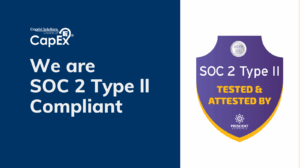What it takes to manage capital expenditure is no small feat. We need considerable time and effort to budget, review, authorize and track capital projects. But, anything worth doing is worth doing well, isn’t it? So, in order to make capital investment a success, we have to optimize the management process.
According to this McKinsey & Co., half of corporate growth is directly attributable to capital investment, and companies that adhere to CapEx best practice are shown to generate an average of 25% higher profits than that of lagging competitors. Take a look at your company’s CapEx management process. Are you finding opportunities for improvement? If the end goal is to maximize growth, an effective capital investment process is the answer.
First thing’s first – have you identified your capital expenditure goals?
A key measure of capital investment performance is ROI. And, the ability to measure ROI should be a primary objective as you strive to achieve corporate growth and profitability. In order to optimize capital project performance, your capital investment has to be consistent with project costs in order to reduce financial risk.
The goal is to minimize cost, and that involves procurement at earlier stages of the investment lifecycle. In order for your company’s procurement team to be effective, they need to look at project cost details from a granular level in order to identify strategic sourcing.
Let’s explore 6 key pillars of CapEx success, and the management capabilities that are necessary to achieve these goals.
1. Integration into your enterprise to control investment costs
Cost control is a key part of CapEx management. As your number of capital investment projects grow, you need to control cost by ensuring that you have access to the most up-to-date cost information, and that this information is easily used to create accurate forecasts without having to employ manual efforts to extract data. And, in order to control costs, you need to ensure that your methods are automated, and that the technology you use is integrated into all levels of your enterprise.
2. The right technology
Data isn’t useful if it isn’t accurate and precise. The right management system can work to provide the necessary data validation that manual processes using spreadsheets simply cannot control. What’s more is that the right solution for CapEx management will be effective because it will provide scalability and security, possessing the ability to hold customer information, delivering reliability every time.
3. An end-to-end solution
The process of keeping accurate data means reducing repetitive data entry. When you leverage an end-to-end solution for CapEx management, you gain visibility across the entire investment lifecycle that enables you to optimize capital allocation. An effective end-to-end solution provides an easier way to report at every stage of the investment process. With the ability to report on projects more efficiently, you will have more time to conduct project analysis on a deeper level while gaining a better understanding of which projects have worked in the past, and what factors contributed to their success or failure.
4. Collaboration and departmental communication
If you are a mid-sized company, you may have hundreds of people across several departments who are managing various capital projects. For a company to make smart decisions on capital allocation, it needs project information that incorporates insights from every area of the enterprise. Gathering this information is a difficult task when investment projects aren’t effectively managed, and, so departments have to have open lines of communication in order to work together to ensure everything is done in collaboration.
5. Ease-of-use
Beyond being a tool for collaboration, effective CapEx technology needs to be easy to use. An intuitive solution works to be adopted quickly while standardizing the investment process and ensuring that project information is managed consistently from inception to execution. As your company gathers project information from every team, you will be able to identify the most promising projects to invest in, both in terms of ROI and value added across the company.
6. Dynamic approvals
A streamlined approval system has the ability to make even the most complex approval workflows easy to manage. The importance of reducing the risk of project overspending is key, and with an effective CapEx management solution, you can automate the process of authorization and budgeting without manual intervention.
In conclusion…
In order to achieve your CapEx goals, you need to manage capital investment effectively. As you begin the process of investigating the best CapEx management solution for your organization, make sure you choose one that will have the capabilities to ensure that your organization determines all the needs to position your company for CapEx success.




